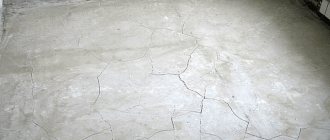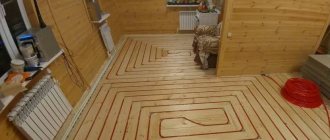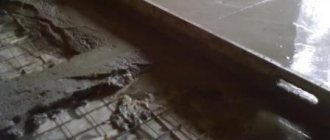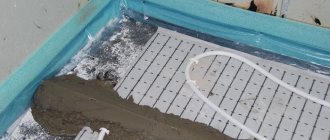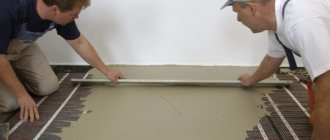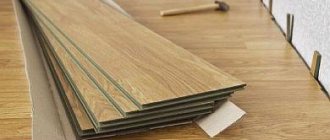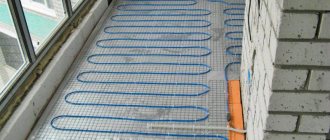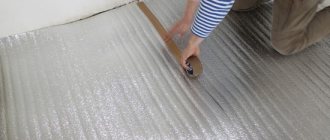Changes in temperature and humidity can negatively affect a seemingly quite durable construction covering - screed, which is necessary to level the floor and correct various defects on its surface. This layer, under the influence of external factors, begins to expand, which creates a certain pressure on the screed itself and the walls of the room. As a result, the integrity of this part of the floor may be compromised. But any hardware store has something that will prevent damage to the cement screed when exposed to various factors - this is a damper tape for floor screed. What is it and how is it used?
Damper tape for floor screed
What is a damper tape and why is it needed?
Expansion of the cement screed - this phenomenon does occur and can cause a lot of harm if the screed was not done correctly. Due to the processes taking place, the screed itself may become cracked or cause damage to other building structures.
Defects in screeds - cracks
Attention! The thermal expansion of a standard, almost universally used sand and cement screed is about 0.5 mm per linear meter. This is quite a lot, considering the hardness of the walls of the room in which this work was carried out.
Cracks in the screed due to expansion
This is why it is necessary to use a damper tape when creating a screed. The latter is a long strip wound into a roll and made of polyethylene foam. The material is soft, plastic, easily compressed under external pressure, and it is precisely due to this that it is able to nullify the expansion of the concrete screed. The damper tape serves as a kind of shock-absorbing layer between the screed and the walls, protecting them from mutual destruction as a result of the resulting pressure.
Damper tape for underfloor heating screed Isolon, 8 mm x 150 mm x 50 m
On a note! Damper tape can also be called buffer, edge, compensation. And its main name comes from the German word Dämpfer, which translates as “silencer”. Thus, the material fully justifies its name.
The expansion tape also provides additional heat and sound insulation and is used as a expansion material and separator when pouring large areas.
Why is damper tape needed?
damper tape for screed
For what purpose and where is it used?
This is a relatively new material, which is consumable and consists of tapes of different thicknesses and heights, made of elastic materials that easily compress under load and restore their shape in its absence. The raw material for production is foamed polyethylene, in closed cells of which there is air.
To understand how the tape works, you can do a simple experiment. If you squeeze it with your fingers, the air bubbles are flattened, the material becomes thinner, but returns to its original size when the pressure is released.
After which it becomes clear why the damper tape is needed. Its main function in the structure of a concrete floor is to compensate for the linear expansion of the screed, preventing its deformation in case of hard contact with the walls. As the slab expands, it presses not on the wall, but on an elastic gasket installed between them and filling the gap between the contacting planes.
Shock-absorbing tape when installing a floating screed Source i2.wp.com
However, the use of such a layer makes sense only if the screed is floating, that is, not connected to the base and mounted on waterproofing (waterproof film) or thermal insulation (insulation boards). If it is laid on a stable base and does not have a heating system, the damper will be useless.
But there are other tasks that can be achieved using this material. When deciding whether a damper tape is needed for a floor screed, you should also remember these:
- Compensation for periodic expansion of heated screeds from a heated floor system.
When the system is running, the plate expands in proportion to the heating force, and when it is turned off, it contracts. Periodically occurring pressure on the walls can ruin the external finish and cause stress and deformation in the structure itself.
On a note! When installing heated floors along external walls, it is better to install strips of insulation. This will not only compensate for temperature changes, but also reduce heat loss.
Diagram of a heated water floor Source pol-inform.ru
- Creating a gap between rooms with different thermal circuits.
In adjacent rooms, different temperatures of the heated floor are often set. Accordingly, it is necessary to arrange a thermal gap between them.
Such a compensator is mounted in a doorway Source eurosantehnik.ru
- Reduced vibration noise.
Another important point why damper tape is needed when screeding is to improve sound insulation between rooms. It dampens vibration and impact noise and prevents its transmission through supporting structures. This is especially true in high-rise buildings, townhouses and country houses with several apartments.
On a note! There is a special type of damper tapes - vibration damping tapes. They are made from rubber, caoutchouc, and other materials and are glued to metal profiles, which are the basis of the frame for interior partitions and wall cladding.
- Reduced cracking when fresh screed matures.
During the drying process, concrete loses moisture and “breaks” with the appearance of cracks. This problem is solved by reinforcing the screed and isolating it from the walls with an elastic gasket. It is laid around the perimeter, as well as in the body of the screed, if its linear dimensions on any side exceed 6-8 meters or the total area of the screed is more than 20 sq.m.
Separating the screed with a compression tape reduces the formation of shrinkage cracks Source chudopol.ru
- Construction of a technological gap between screed sectors poured at time intervals.
When a fresh screed comes into direct contact with a previously poured screed that has already gained strength, uncontrolled stresses arise that affect the strength of the coating. They are compensated by laying a buffer layer between adjacent sectors.
Summarizing the above, such a gasket must be done in the case of a floating screed or heated concrete screed. If we answer the question whether a damper tape is needed when pouring a self-leveling floor, then it will be positive only if there is a thick layer of leveling mixture or when it is installed on top of a heated floor. Simple thin-layer coatings up to 10 mm high do not need an edge around the perimeter of the walls.
When installing thin-layer self-leveling coatings, a buffer layer is not needed Source i.ytimg.com
All other cases are considered individually, the choice remains at the discretion of the home owner.
Advantages of damper tape
Buffer tape does its job perfectly and has a lot of advantages. It is precisely due to the special properties of the material from which the tape is made that it cannot be fully replaced by other materials.
Correct application of the damper tape is a prerequisite when pouring the floor
Advantages of buffer tape:
- sufficient softness and plasticity to perform its functions - foamed polyethylene easily wrinkles and then restores its shape if necessary;
- excellent thermal insulation properties. This feature reduces heat leakage through the joints between walls;
- high sound insulation rate;
- environmental friendliness and complete safety for human health;
- the ability to provide waterproofing in installation areas;
- durability and strength of the material;
- ease;
- high resistance to external factors;
- complete resistance to biological factors - polyethylene does not rot, fungi and other parasites do not settle on it;
- very simple installation method.
Laying damper tape for floor screed
The only disadvantage of damper tape is its high cost. Using tape in repairs and construction can cause a serious blow to the budget. But, due to its advantages, this material is quite often used for repairing premises for various purposes - from residential to industrial. The damper tape does not have any negative reviews.
Self-adhesive damper tape
Materials, types, types
The polyethylene from which the damper tape is made can be uncrosslinked or crosslinked. Unstitched is cheaper, but less elastic, the walls can burst under significant load. Sewn is many times more expensive, but also more reliable. This explains the significant price difference that can be found for material of the same length/width/thickness. The type of material is indicated in the specifications. Also, the price depends on the density. This characteristic is not always indicated, but an indirect sign of higher density is greater mass. You just need to take into account the size of the tape.
T-shaped damper tape for organizing expansion and intercontour seams
There are two types of damper tape for screeds: edge and intercircuit T-shaped. The edge one is the one that rolls along the wall. Intercontour is used when constructing expansion joints in screeds - with a large floor area (more than 6 meters in length). It is more convenient to install it in a doorway; this material is used to separate the screed in the area of action of different heating circuits for water heated floors.
Types of edge (edge) damper tape
There are three types of tape:
- Standard. It's just a strip of polyethylene foam.
- With self-adhesive base. An adhesive composition is applied to one side, protected with wax paper. During installation, the paper is removed and the material is pressed against the wall. Due to the adhesive composition, it is fixed.
- With a skirt. Damper tape with a polyethylene outlet on one side. The width of the outlet is from three to ten centimeters. During installation, the skirt is laid out on the floor. This material also reduces the likelihood of leaks at the junction of the wall and floor, which is important.
The waterproofing is placed on the walls and secured, then the damper tape is unrolled and attached.
If waterproofing is spread on the floor, it is usually placed on the walls and secured there. The damper tape is laid in front of the waterproofing (as viewed from the center of the room). It turns out to be a double layer of material to some height, but this is not a problem.
Additional Buffer Tape Features
As a rule, compensation tape is installed only around the perimeter of the rooms when installing the screed. However, it can also be used for other jobs - all of which are related to the floor. For example, expansion tape is often used as a barrier to spreading mortar, or as a separator if the screed has a large area. However, when installing a self-leveling floor, such a tape does not need to be used.
Damper tape - a panacea for cracking (destruction) of concrete
Damper tape can be used not only for internal, but also for external work. For example, when constructing a blind area. It will protect concrete from cracking during sudden temperature fluctuations. In this case, the tape is laid in the expansion joint between the blind area and the wall.
The process of creating a concrete blind area
Video - Floor filling technology
How to install and secure
The edge damper tape is laid out along the perimeter of the walls. If the tape has an adhesive strip, there are no discrepancies. We unfold it so that the glue faces the wall. If there is no adhesive strip, the shiny side should be turned towards the wall, release the film (if any), lay it out on the floor. We do not stretch the tape, we lay it loosely. Those with skirts can generally wrinkle a little, otherwise the skirt will be stretched. In the corner on the floor, fold the release of the plastic film into a triangle. There's no point in trying too hard to post it. Just to avoid coattails.
When laying, the damper tape is not stretched. The skirt is straightened on the floor
In general, everything is simple. The manufacturers themselves roll the material so that it is convenient to install. Material for right-handed people has been rolled up. That is, we place the roll on the floor, secure the edge and then roll it out from left to right. If two pieces are connected, an overlap of about 5 cm is needed.
You can attach the damper tape to the wall using staples, glue, tape or... Not at all
The quickest and easiest way to attach the damper tape to the walls is with staples from a construction stapler. You can use liquid nails, double-sided tape. The question is not fundamental. You don’t have to fasten it at all, but then when laying concrete and during further work, you will need to make sure that the damper tape does not fall.
At what height should the fasteners be installed? The best option is in the middle of the width of the tape. In any case, not higher than the planned finished floor line. In most cases it is cut off, so it will be easier if the fasteners are installed lower. It is not necessary to trim off the excess, but it seems more “aesthetically pleasing.”
What should you consider when purchasing damper tape?
Demand creates supply, and therefore in the construction market there is now a large selection of damper tapes from various manufacturers. They differ from each other in technical characteristics, appearance, and price. Due to the fact that the market offers a large selection, it is not easy to settle on the tape of any one manufacturer. You will have to study the proposed options and choose the best one with the optimal price-quality ratio.
Choosing the right damper tape
First, you should get acquainted with the form in which the damper tape is sold. It is sold in rolls, which are easy to transport due to their lightness and relative compactness. This aspect is also useful when installing the material - you don’t need to cut anything.
On a note! The cost of one roll usually varies between 500 rubles, although there are more expensive types. When decorating a small room, the costs will not be large, but for large rooms and halls you will have to purchase a lot of tape. When drawing up an estimate, it is better to immediately include the tape in the list of required materials.
Despite its resistance to external factors, the material should be stored in dry rooms at room temperature. In this case, the tape must be wound into a roll.
Compensation tape on a roll
Attention! During transportation, it is advisable to avoid severe mechanical damage and impact on the tape - these factors can worsen the performance properties of the material.
Damper tape in a heated floor system
When choosing a tape, you should pay attention to the following parameters.
- Integrity and absence of deformation . The tape should be smooth and neat. Damaged tape should not be purchased.
- Appearance . The tape must be clean, free from stains and defects.
- Roll density . If there are delaminations or cracks in the roll, then there is a risk that the adhesive surface is damaged and unusable.
You should not give preference to a tape that is cheaper but has defects. As a result, the quality of all screed installation work may ultimately suffer.
Tape laying process
Possible alternative
During installation and operation, a number of problems and difficulties may arise. In most cases, this is due to insufficient preparation of the premises. To minimize technology violations, it is recommended to familiarize yourself with the advice of specialists.
Often the factory tape may not be available. But to ensure the safety of the coating, its closest analogue should be installed. How to replace the damper tape in this case? The main selection criterion is the material of manufacture. Foamed polyethylene can be replaced with similar polymer compositions.
Most often, penofol is used for this. Its main disadvantage is its small thickness, which cannot provide the required minimum clearance. The multilayer gasket option will be impractical. Over time, the layers may lose their original location, resulting in changes in thickness in certain areas.
Installation of wooden blocks is also not recommended. They have the following disadvantages, which will be reflected in the properties of the entire coating:
- Changes in geometry under the influence of humidity. Fibers have the ability to absorb water;
- Possibility of mold and mildew. This is characteristic of almost all natural materials;
- Short service life due to the factors described above.
The alternative material must have sufficient flexibility, but at the same time return to its original dimensions after the end of exposure to the surface. Installing foam edges will not produce the desired result.
Cost and manufacturers
The most popular manufacturers of tapes, which have earned the trust of the buyer and are used by construction companies, are known to most from other products for repair. These are Knauff and Energoflex.
Edge damping tape 100 mm x 20 m
Table. Characteristics of Knauff, Energoflex and Leroy Merlen tapes.
| Brand | Description and characteristics of the tape |
| Knauff | Made of polyethylene foam and polyethylene film (skirt). The material ensures high quality work. Can be used for arranging self-leveling floors. The width of the tape is 10 cm, the length of the product in one roll is 40 m. The main disadvantage is the high price. |
| Energoflex | The tape is used to compensate for the expansion of screeds, including when installing heated floors. It has a skirt that prevents the solution from penetrating under the edges of the tape itself. The thickness of the product is 10 mm, the length of the tape in a roll is 11 m. The product, as a rule, is installed completely around the perimeter of the room, if the screed area does not exceed the required 10 m2; if the area is larger than this value, then it is necessary to provide compensation seams. |
Knauf damper tape
SoundGuard Band Rubber, 50 mm
Damping tape SoundGuard Vibro EcoRoll
Energofloor damper tape
Prices for damper tape VALTEC
Valtec damper tape
Standard sizes of compensation tape
Any type of damper tape comes in the form of rolls. Which in turn can have different lengths. This parameter mainly depends on the width of the tape.
- Standard lengths range from 10 to 100 meters;
- width can be in the range of 20-150 mm;
- Its thickness can range from 3 to 10 mm.
When choosing the required size, you should rely on the area of the future screed and its thickness.
- The width of the tape is selected based on the following calculation: the height of the screed at the highest point + 2 cm. The tape must protrude above the concrete in order to completely eliminate even the slightest contact with the wall;
- The larger the pouring area, the thicker the damping tape should be. This is necessary so that voltage compensation occurs fully. For large areas, it is better to use the T-shaped variety;
- When calculating the required amount of tape, you should take into account not only the length of all walls, but also remember to go around various protruding surfaces - columns, partitions, etc.
Installation of damper tape for screed
Installation of the damper tape begins before the concrete screed is poured. It is laid along the perimeter of the room. If there are columns, material will be laid around them.
Let's start installing the damper tape
Table. Laying damper tape with your own hands.
| Steps, photo | Description of actions |
| Step 1 | Laying the damper tape starts from the corner of the room. Since the tape is supplied in rolls, installation is very convenient, gradually unwinding the required amount of material. If the tape is self-adhesive, then during installation the protective layer is removed from the back surface and the tape is glued. A conventional product is attached using adhesives or self-tapping screws. |
| Step 2 | The material is laid continuously. If the room is too large and one roll is not enough in length, then the edges of the strips can be overlapped with each other. |
| Step 3 | The corners of the rooms are carefully taped. In these places the tape is pressed very tightly against the walls. |
| Step 4 | The installation is completed at the moment when the tape returns to the starting point. At this point it is cut with a stationery knife so that there is a slight overlap. |
After completing the installation of the damper tape, you can walk over it with a roller to seal the connection between the material and the wall. If the screed area exceeds 10 m2, then it is advisable to divide it into separate sectors. In this case, the principle of installing the tape does not change.
Installation of expansion joints in floor screed
Video - Installation of damper tape
Table. Installation of dry screed using damper tape.
| Steps, photo | Description of actions |
| Step 1 | First of all, the subfloor - the base - is thoroughly cleaned of debris. |
| Step 2 | The base is covered with polyethylene film for waterproofing. |
| Step 3 | A damper tape is laid and secured around the perimeter of the room. |
| Step 4 | The corners are well glued so that the tape does not fall behind. |
| Step 5 | The filler – expanded clay sand – is scattered over the prepared surface, starting from the highest point of the floor. |
| Step 6 | The thickness of the sand layer should be at least 4 cm, but not more than 12 cm. By the way, various communications can be laid inside the layer, if necessary. In this case, the layer should overlap them by 2 cm, no less. |
| Step 7 | The coating is leveled. The most convenient way to do this is by lighthouses. Then the surface is compacted with a rubber hammer. |
| Step 8 | The evenness of the base is checked using a building level. |
| Step 9 | The sand layer is covered with gypsum fiber sheets. |
| Step 10 | The sheets are attached using glue and screws. After this, the screed should rest for about 2-3 days, and then the repair work can continue. |
What can be replaced
In general, damper tape is not the cheapest material. It is quite possible to find materials with the same properties, but cheaper. Without a skirt and an adhesive layer, but this is advanced functionality. If your budget is limited, you can replace the edge damper tape:
- polyethylene backing for the laminate, cut into strips of the required width;
- rubber band;
- old linoleum;
- penofol cut into strips.
If you are pouring screed over joists, you also need damper tape.
There is another cheap option. Instead of damper tape, use thin wooden strips wrapped in plastic film. After the concrete has set, they are removed. A void can be left, or it can be filled.
How to fill the seam
In general, damper tape is a consumable material. That is, it is not removed from the screed and is not reused. But if you don't like the idea, you can delete it. And so that the gap does not fill with debris and insects do not live in it, it is filled with silicone sealant, which remains elastic after drying. But this option cannot be called cheap. The high consumption of expensive silicone makes savings irrelevant.
Buffer/damper/edge/edge floor tape for screed: how to install it
You can fill the gap with foam. Cut off the excess after hardening, but not to the level with the coating or screed, but a little deeper. Apply the same silicone on top. And the elasticity will remain, and there will be no gaps, and debris/insects will not annoy.
How and with what to cut
Most substitutes for damper tape are rolled materials. They can be cut into strips of the required width. If you need to be more or less careful, take a board, a sharp knife and a long ruler. Roll out the substrate, Izolon or other selected material. We lay a board under it along the edge. Place a ruler at the required distance from the edge and cut.
Ready for further work
To speed up the process, we fold the material in several layers, and then everything is the same. We put the board down, apply a ruler and cut along it. But we try to cut through all the layers at once down to the wood. It doesn't work out very nicely, but it's much faster.
Another way is to hang it with scissors. But this is not ideal at all, so you can do what is necessary. It’s also long and tedious, especially if you have to cut it for the whole apartment or house. The total is more than a hundred meters. So be patient. You can speed it up by sawing with a saw. If you are not a perfectionist, this is a great way.
Methods for attaching edge strips
The damper tape must be fixed during installation. But if it does not have an adhesive strip, then alternative fastening methods can be used.
- A furniture stapler and staples will allow you to secure the tape to walls made of foam or aerated concrete, as well as wood.
- Self-tapping screws, dowels, hammer drill and screwdriver . Not the best option, since the tightness of the material is severely compromised. A method suitable for brick walls.
- Liquid Nails . Suitable for poorly leveled walls.
- Masking tape will allow you to temporarily fix the tape while you pour the screed.
Damper tape when installing heated floors
Is it possible to do without it?
Some experts argue that expansion tape is only needed for floating screeds. If the CPR is poured directly onto a rigid base, for example, in a garage on a concrete floor slab, then you can do without a damper tape. It is not needed for self-leveling floors with a thin layer of self-leveling mixture.
Let's try to figure out whether a damping strip is needed in the listed cases. Let's start with the screed. Let's not theorize, but refer to accumulated experience. There is no need to go far - look at what is happening (or was happening) with the screed in houses built in the 80s of the last century: CPR was poured directly onto the floor slabs without a damper tape (it began to be widely used in the late 90s). After a few years, the layer of mortar crumbled, in most cases in the heating area. Fortunately, there is linoleum on top, which is not critical for the floor covering.
The argument about thin self-leveling floors is also unclear. For thick people it is necessary, for thin people it is not. Where is the logic? After all, linear expansion in length/width does not depend on the thickness of the concrete. It is always equal to 0.1 mm per 1 m of length when the temperature increases by 1oC. Let us especially emphasize - at +1oС.
Where you really don't need a damper tape:
- frame houses. The walls there are not concrete or brick, and the screeds do not provide resistance to linear expansion;
- The thermal insulation is made with rolled materials extending onto the walls to the thickness of the CPS filling - they act as a shock absorber.
Conclusion: damper tape is always needed for hard walls. The owner of a house or apartment can refuse the compensation gap only at his own peril and risk.
As for the damper tape for the profile under plasterboard, in the bathroom when installing a false wall (box), it is required. When installing interior walls, it is advisable to lay. But nothing bad will happen if the owners refuse to use the compensator strip.
Recommendations for selection
Damper tape is an ideal object for counterfeiting. A student can print (download and then print on a color printer) the insert. Cutting the tape itself from the roll backing is just as easy. Roll it up and seal it in cellophane - no problem. Therefore, when shopping for goods, you need to study some nuances.
- While at home, you need to decide on the width and thickness of the tape, as well as its appearance.
- The tape must be in undamaged packaging, box (packed by European manufacturers) or film. This will protect you from many troubles.
- If the packaging is damaged, the following steps should be taken:
- ask to see a certificate of conformity;
- check the density of the bay, especially a large one - they could rewind ten meters;
- make sure the strip is intact, and if there is a skirt, then that too. If there is damage, even at a discount, it is better to refuse the purchase.
- The self-adhesive tape should not have partial peeling of the protective strip - the glue has lost its properties.
- The thickness should be the same along the entire length, which is clearly visible on both sides of the bay.
- The cutting line must be perfect. Irregularities indicate a fake.
- Dirt on the surface is not allowed.
- Preference should be given to trusted manufacturers.
How to choose
When making your own choice, it is very important to pay special attention to several basic, most important parameters of this auxiliary building material:
- absolute integrity of the material;
- complete absence of any deformation on the tape;
- the material must be smooth and neat;
- The protective backing from the self-adhesive tapes should not come off.
Damaged tapes must be discarded immediately
It is important to pay attention to the appearance of the material and the density of the roll, the absence of delaminations and cracks. It should be noted that high-quality material cannot be too cheap and is not sold at a significant discount due to its non-marketable appearance
Material requirements
The basis for high-quality edging tape is, as a rule, polyethylene foam raw materials, which is a chemically neutral, practically non-flammable and environmentally friendly material with a characteristic closed cellular structure. It is this type of source material that is distinguished by decent heat and sound insulation qualities, good moisture resistance, and also increased resistance to direct sunlight.
Roll size and length
Currently, there are several standard sizes, according to which compensation material is produced by foreign and domestic manufacturers. The best option is considered to be products with a width of about 150 mm with a thickness in the range of 4–10 mm, which are sold in rolls of 50 m.
Table: main typical dimensions of expansion tape
| Length (m) | Thickness (mm) | Width (mm) |
| 25 | 10 | 100 |
| 11 | 10 | 150 |
| 11 | 10 | 100 |
| 25 | 10 | 100 |
| 50 | 10 | 150 |
| 20 | 8 | 80 |
| 25 | 8 | 100 |
The width of the material, as a rule, is selected taking into account the thickness of the future concrete screed. When rough pouring a concrete screed, it is quite enough to use a tape having a width of 100 mm. The construction of a thickened concrete screed requires the use of a strip with a size of about 150 mm. Forming a wall joint with the required parameters involves taking into account the area of cement pouring under the conditions of possible temperature changes characteristic of the room being equipped.
Manufacturing companies
Experts recommend giving preference to products manufactured exclusively by proven and reliable manufacturing companies, whose products not only have the proper quality, but are also characterized by the availability of self-installation and the longest possible service life. The most common brands on the domestic market are Tilit-Super, Uponor and Wolf Bavaria Viles Band, Teploflex, Valtec, Energoflex Super and Uponor Minitec, Soundguard Band Rubber, as well as Knauf.
Installation of damper connection
- First you need to cut the waterproofing material into strips of 35-45 cm. The cut strips need to be laid around the perimeter of the room, rising along the wall slightly higher than the height of the future screed. When joining two strips, you need to overlap 15-20 cm.
- The edge raised along the wall must be secured with liquid nails or tape every 40 centimeters so that it does not fall when laying the screed.
- To compensate for the thermal expansion of the screed, on top of the waterproofing strips, along the wall, you need to lay Izolon type insulation 1 cm thick. The insulation needs to be cut into strips of 9-16 cm.
- After installing the damper, its waterproofing layer will prevent the water in the solution from leaking to the neighbors and protect the screed from breaking. Soft insulation will absorb changes in the screed due to fluctuations in temperature and air humidity.
Advantages and disadvantages
The damper tape has a number of significant advantages:
- durability - the service life is comparable to the service life of the screed;
- elasticity - volume and geometric dimensions are restored when the load is removed;
- good thermal insulation properties - thermal conductivity coefficient no more than 0.035 W/(m*K);
- ability to cut off structural noise;
- environmental safety - does not emit harmful substances when heated, is not an allergen;
- the material does not rot or decompose;
- low moisture absorption - picks up no more than 2% water per day;
- simple fastening;
- affordable price.
Among the disadvantages is flammability.
Installation features
The developer may have a question about how to attach the damper tape and when to do it. Installation is carried out before pouring the screed, but after installing the waterproofing. As a rule, film and any other waterproofing on the sides is lifted and placed on the walls, in which case the buffer tape is installed on top of it.
The installation method depends on the type of product. If it has an adhesive layer, everything is simple: place the roll with the sticky side to the wall and, gradually unrolling it and removing the protective layer, glue the strip to the base, slightly pulling it so as not to falsify. If there is a film release (“skirt”), it is spread on the floor, folded at the corners into a triangle.
Installation of L-shaped tapeSource o-builder.ru
Having finished gluing one roll, the second is mounted overlapping, starting the beginning of the second strip 5 cm from the end of the first.
If there is no adhesive strip, you first need to determine the front and back sides. The reverse side is usually smoother and shiny, and it is pressed against the wall.
Rigid fastening is not necessary - the strip can simply be pressed with the solution during its installation. But this is very inconvenient: you have to constantly make sure that it does not fall or bend under the screed, otherwise the whole point of why the damper tape is needed is lost.
Therefore, choose one of the most convenient fixation methods:
- shoot with a stapler, the staples of which easily fit into the wooden base;
- drill the dowel with nails;
- glued with double-sided tape, liquid nails or other adhesive.
DIY strip laying
The damper tape is laid around the entire perimeter of the room between the screed and the wall.
First, the surface is treated with a primer. Then, when it dries, glue the damper its width to the base of the wall.
If the edge tape is self-adhesive, then it is simply glued to the wall, removing the backing. The strip with the skirt is folded onto the floor so that the solution cannot get into the cracks. If the edge tape does not have an adhesive composition, then glue it to liquid nails and screw it with self-tapping screws. Sometimes damper tape is attached to the wall with small nails, a construction stapler, glue, or double-sided tape. You can press it with a solution. The strip must be installed above the level of the floor screed.
When the flooring is ready, it is not removed, but only the excess is cut off. If skirting boards are installed, it is not necessary to cut off the excess. When installing a water or electric heated floor, the damper tape must be laid between the heating element and the vapor barrier layer. Sometimes the strip can be placed under a vapor barrier. The damper must also be installed around the perimeter in the heated floor system and only then proceed to the doors.
You should use a long strip rather than save money by folding the damper from several overlapping cut strips. Such poor quality work can lead to problems during system operation. After installation, the tape must be smoothed, pressing carefully to eliminate minor defects. This must be done not with your hands, but with a construction roller, following the installation rules so that solvents do not get on the tape and deteriorate its technical characteristics.
How to attach damper tape
There are 5 types of damper tape:
- Regular edging.
This is a simple strip of polyethylene foam that compensates for concrete expansion. There is no adhesive composition on it;
- Self-adhesive tape.
There is an adhesive strip on its reverse side. It is smaller in size and covered with a backing. The backing is removed and the tape is applied to the wall with the adhesive side. This is very convenient, because when pouring a concrete screed, it fits tightly to the wall and does not move. The adhesive composition under the protective film has high adhesion. The strip quickly and firmly sticks to any building material: wood, plaster, concrete;
.
Edgeband with skirt
The skirt is a piece of durable oilcloth material extending from the polyethylene part. When the damper tape is fixed to the wall, it covers the angle between the floor and the wall, thus sealing it. The width of the skirt varies from 3 to 10 cm. Such damper tapes are found both regular and self-adhesive;
consist of 2 parts - a wide and a narrow part. The wide part is attached to the wall, the narrow part to the floor. Such strips are bent at right angles. In order to better lay such a tape, there are cuts on the fold. A skirt can be attached to the L-shaped edge band. Such a damper can be ordinary, without glue, and an adhesive composition can also be located on each of the parts. Such an edge tape best protects the wall from the screed and prevents the mortar from getting into the cracks between the foundation and the wall;
L-shaped damper tapes- There are T-shaped tapes .
They are used for heated floors, for long walls (if the wall is longer than 80m), as well as for screeding a large area (more than 40 square meters) as an expansion joint.
What are the sizes of edge tape?
Damper tape is sold in rolls from 10 to 100 m, width from 50 to 150 mm.
The thickness also varies. It varies from 0.1 mm to 1 cm. The best thickness is considered to be 5mm. At the same time, they say that the thicker the screed, the thicker the edge tape should be.
In order to quickly and conveniently remove the excess part when laying the strip, longitudinal notches are made every 4-6mm. By pulling the edge, you can tear off part of the tape along the entire length.
How to determine the required dimensions of the damper strip?
To buy a tape of a certain width, you need to calculate it. To do this, find the sum of the thickness of the rough fill and the finishing layer of the floor covering. To this amount you need to add a few cm1-1.5 for reserve.
The length is determined by the perimeter of the room. Increases are made for columns, partitions and a small reserve just in case. The thickness depends on the height of the screed.
How to choose a damper tape
- The damper strip must be inspected. If there is mechanical damage on it, then it may be of poor quality and will not have a compensating effect on the screed, which will lead to its destruction, and then damage to the floor covering.
- The tape must be tightly twisted, otherwise the adhesive composition may come away from the wall during installation. Poorly glued tape will lead to destruction of the screed.
- You need to pay attention to the appearance of the tape, eliminating any signs of low-quality goods: stains, defects.
- It is best to choose a damper with a cutting ruler in order to quickly remove its excess after work.
- Self-adhesive tape will save your time and secure the material more reliably. But such tape is more expensive.
Only by carefully choosing a product can you avoid troubles: destruction of the floor covering.
How to replace damper tape
Sometimes, wanting to save money on a factory damper tape, they use alternative options. Some try to make a strip on their own, using materials such as polystyrene foam, isolon, folgoizol. But all these materials do not have all the properties of foamed polyethylene. Poor-quality damper tape can lead to the appearance of microcracks in the screed and reduce the service life of the floor covering.
Do you need a damper tape for a self-leveling floor?
When installing self-leveling floors, additional tools and materials are used. One such device is a damper tape. It protects the floor surface from cracks and prevents its destruction.
The purpose of the tape when installing a self-leveling floor is to isolate it from walls or different rooms in an apartment where there are no thresholds. It is easy to install. Unwinding the roll, glue the tape around the perimeter of the room. Then we start pouring the self-leveling floor. Sometimes builders do not install the tape; as a result of the deformation processes of the building and temperature changes, pressure from the screed on the walls may occur. But since the walls are harder than the self-leveling floor and screed, cracks begin to form on it, which expand over time and lead to the destruction of concrete.
Sometimes, when installing self-leveling floors in different rooms that are not separated by a threshold, damper tapes are used. In the passage space, a damper joint is made from tape, which compensates for the expansion of the concrete screed. After the self-leveling floor dries, small cracks appear above the damper joints, which should be covered with sealant if the floor is made of polymer, or with mortar if a self-leveling concrete mixture is used. In this case, the damper joint saves the self-leveling floors from destruction.
